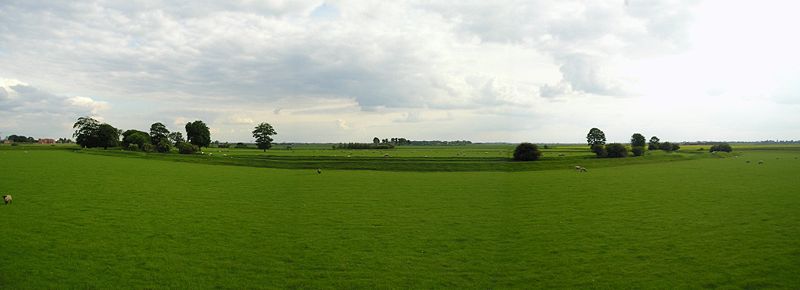
Stonea Camp
Encyclopedia
Stonea Camp is an Iron Age
hill fort
located near March
in the Cambridgeshire
Fens. Situated on a gravel bank just 2 metres (6.6 ft) above sea-level, it is the lowest hill fort
in Britain. Around 500 BC, when fortification is thought to have begun at this site, this "hill" would have provided a significant area of habitable land amidst the flooded marshes of the fens. The site exhibits at least two phases of development over several hundred years of settlement, with a D-shaped set of earth banks surrounded by a larger, more formal set of banks and ditches.
, between the Iceni tribe and a Roman auxiliary force under governor Ostorius Scapula. Human remains have been found around the site including sword-marked adult bones and the cleaved skull of a child, indicating that the inhabitants were trapped and attacked within the settlement.
The remains of a multi-storey Roman tower have also been excavated within sight to the north of the Stonea Camp fortifications. The building was probably constructed to suppress further tribal rebellion or settlement at this site.
, and restoration work followed in 1991 to recover the outer bank system and ditches which have been worn away by agriculture. The Cambridgeshire County Council Archaeology department has continued to carry out restoration work at the site.

Iron Age
The Iron Age is the archaeological period generally occurring after the Bronze Age, marked by the prevalent use of iron. The early period of the age is characterized by the widespread use of iron or steel. The adoption of such material coincided with other changes in society, including differing...
hill fort
Hill fort
A hill fort is a type of earthworks used as a fortified refuge or defended settlement, located to exploit a rise in elevation for defensive advantage. They are typically European and of the Bronze and Iron Ages. Some were used in the post-Roman period...
located near March
March, Cambridgeshire
March is a Fenland market town and civil parish in the Isle of Ely area of Cambridgeshire, England. March was the county town of the Isle of Ely, a separate administrative county between 1889 and 1965, and is now the administrative centre of Fenland District Council.The town was an important...
in the Cambridgeshire
Cambridgeshire
Cambridgeshire is a county in England, bordering Lincolnshire to the north, Norfolk to the northeast, Suffolk to the east, Essex and Hertfordshire to the south, and Bedfordshire and Northamptonshire to the west...
Fens. Situated on a gravel bank just 2 metres (6.6 ft) above sea-level, it is the lowest hill fort
Hill fort
A hill fort is a type of earthworks used as a fortified refuge or defended settlement, located to exploit a rise in elevation for defensive advantage. They are typically European and of the Bronze and Iron Ages. Some were used in the post-Roman period...
in Britain. Around 500 BC, when fortification is thought to have begun at this site, this "hill" would have provided a significant area of habitable land amidst the flooded marshes of the fens. The site exhibits at least two phases of development over several hundred years of settlement, with a D-shaped set of earth banks surrounded by a larger, more formal set of banks and ditches.
Roman control
The fort is a possible site of the battle of 47 AD mentioned by TacitusTacitus
Publius Cornelius Tacitus was a senator and a historian of the Roman Empire. The surviving portions of his two major works—the Annals and the Histories—examine the reigns of the Roman Emperors Tiberius, Claudius, Nero and those who reigned in the Year of the Four Emperors...
, between the Iceni tribe and a Roman auxiliary force under governor Ostorius Scapula. Human remains have been found around the site including sword-marked adult bones and the cleaved skull of a child, indicating that the inhabitants were trapped and attacked within the settlement.
The remains of a multi-storey Roman tower have also been excavated within sight to the north of the Stonea Camp fortifications. The building was probably constructed to suppress further tribal rebellion or settlement at this site.
Excavation and restoration
Excavation work was carried out in 1980 by the British MuseumBritish Museum
The British Museum is a museum of human history and culture in London. Its collections, which number more than seven million objects, are amongst the largest and most comprehensive in the world and originate from all continents, illustrating and documenting the story of human culture from its...
, and restoration work followed in 1991 to recover the outer bank system and ditches which have been worn away by agriculture. The Cambridgeshire County Council Archaeology department has continued to carry out restoration work at the site.


